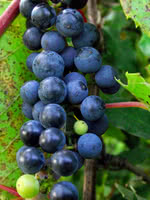Mon-Fri 9am - 5pm Mountain time
Riverbank Grape vs Grouseberry
Vaccinium scoparium
Vitis riparia
CUSTOM GROW
CUSTOM GROW
Grouseberry is a native, low-growing deciduous shrub known for its edible red berries. In early summer, it produces small, urn-shaped flowers ranging from white to pink that attract bees and other pollinators. The berries provide an important food source for many types of wildlife, including game birds such as grouse, which gives the plant its common name. People can also enjoy the berries fresh or in baked goods, though they can be difficult to harvest in large quantities.
Spreading by rhizomes, Grouseberry forms dense, broom-like mats that help stabilize soil and prevent erosion, while also providing cover for ground-nesting wildlife. It is commonly found beneath conifers in open forests, subalpine meadows, and occasionally on rocky slopes in mountainous regions. It is well-suited for naturalization, ecological restoration, and soil stabilization projects.
The Riverbank Grape, also known as the Frost Grape, or Wild Grape, is a cold-hardy variety that produces fragrant white flowers in the spring and then tart, purple grapes late in the summer.
The Riverbank Grape is a vigorous grower that attracts lots of wildlife, who enjoy the fruit and flowers. This plant is native to North America, and is also highly resistant to fungal diseases, making this a great addition to your city gardens. This plant does best with a trellis.
Note: We do not ship grape vines to BC due to regulatory restrictions from the Canadian Food Inspection Agency.

